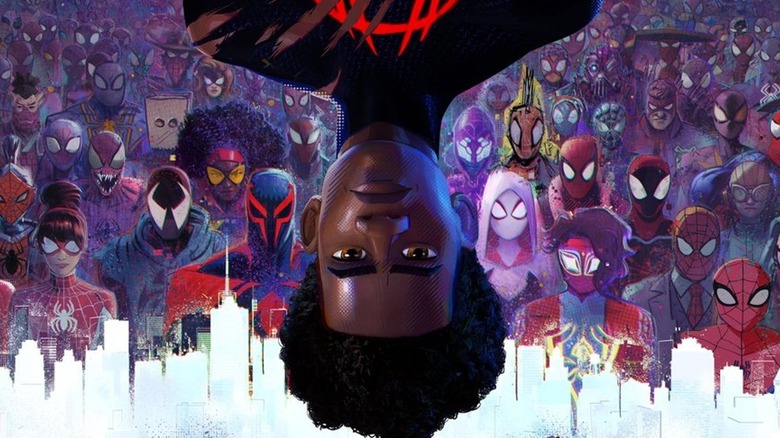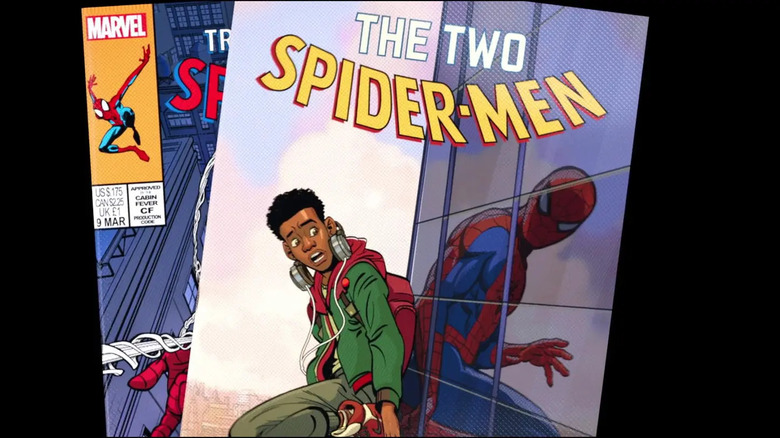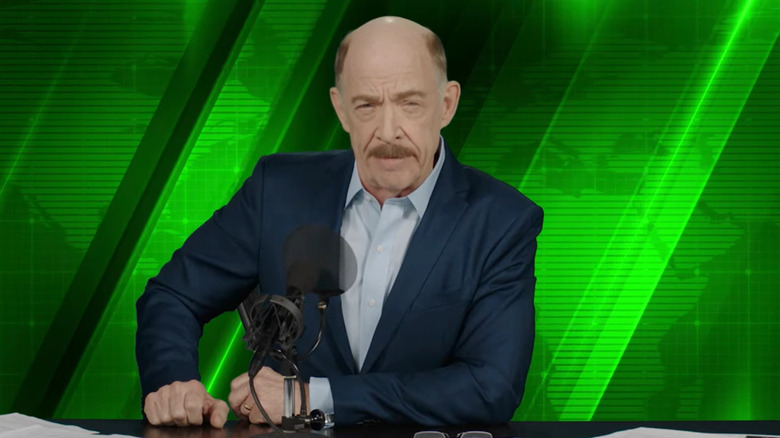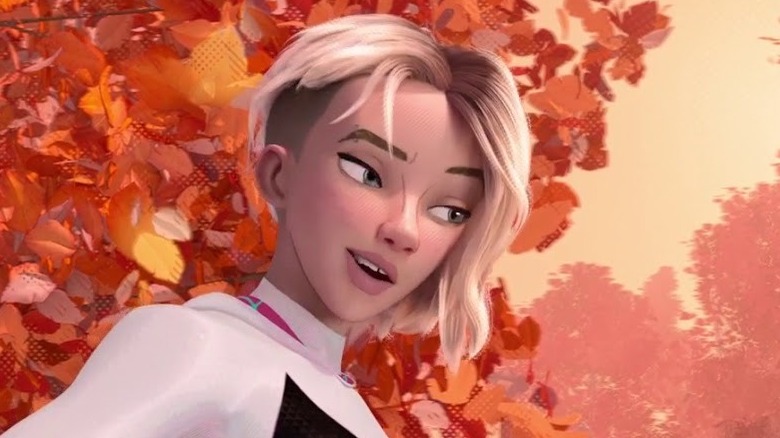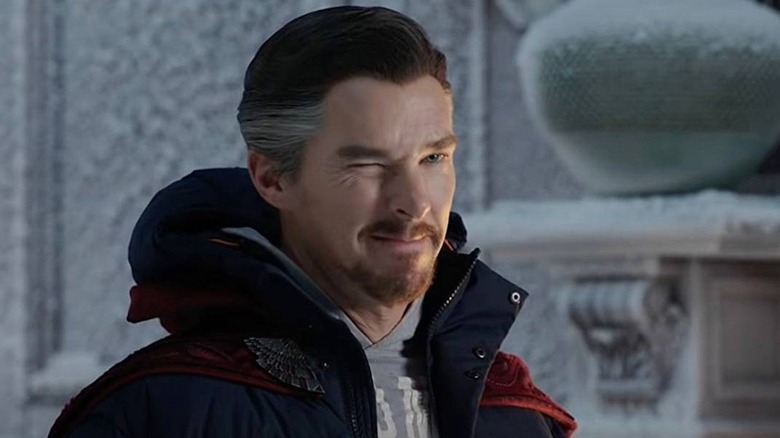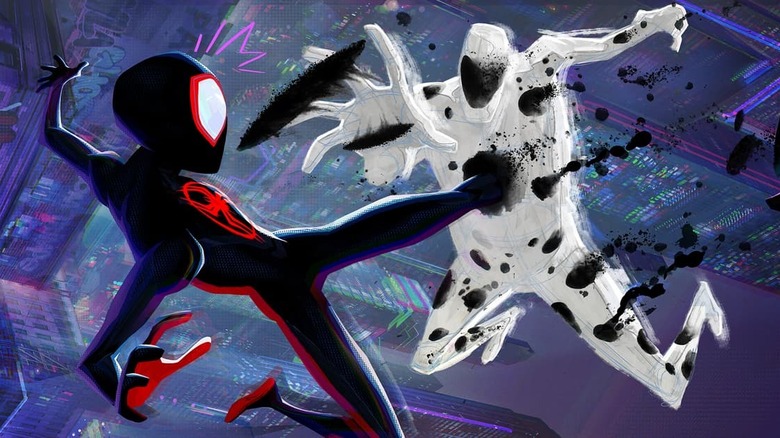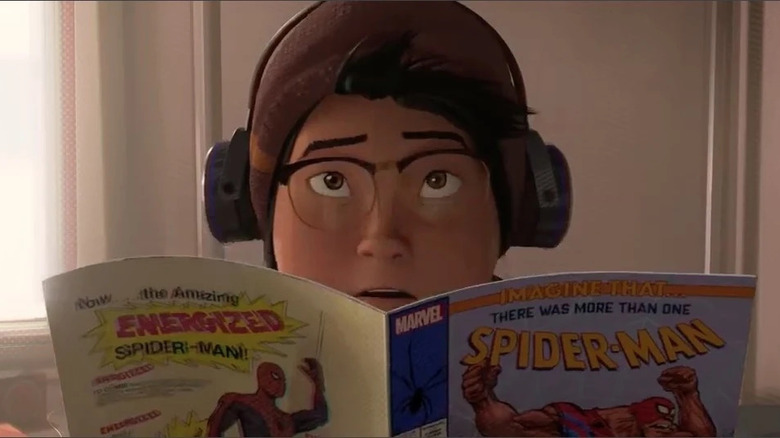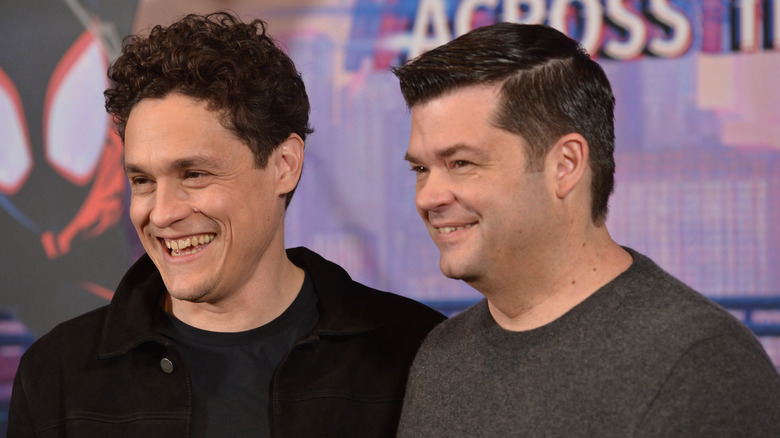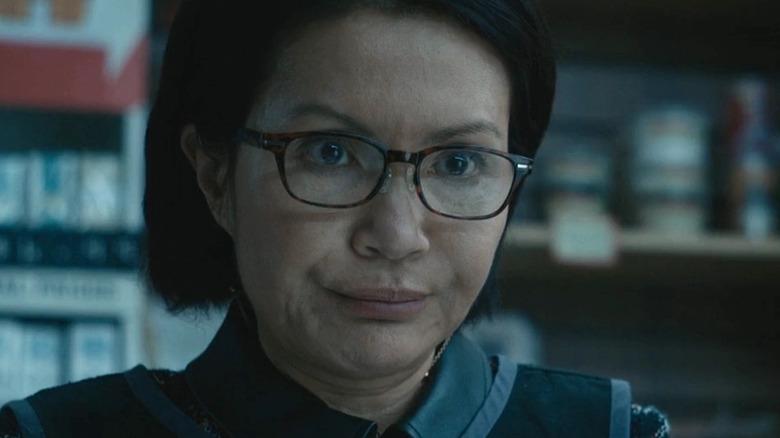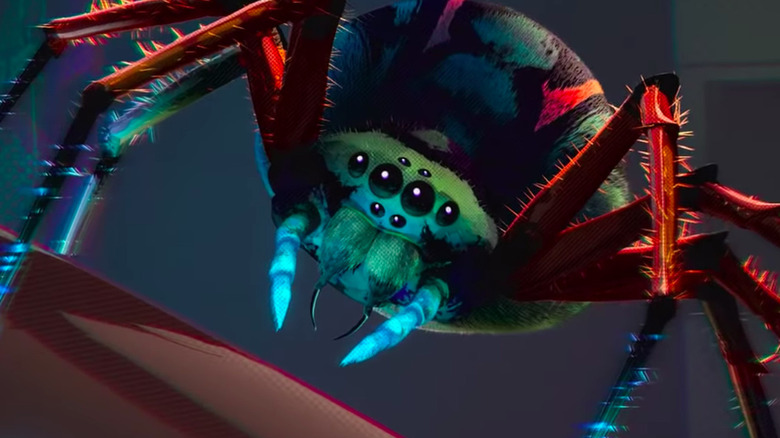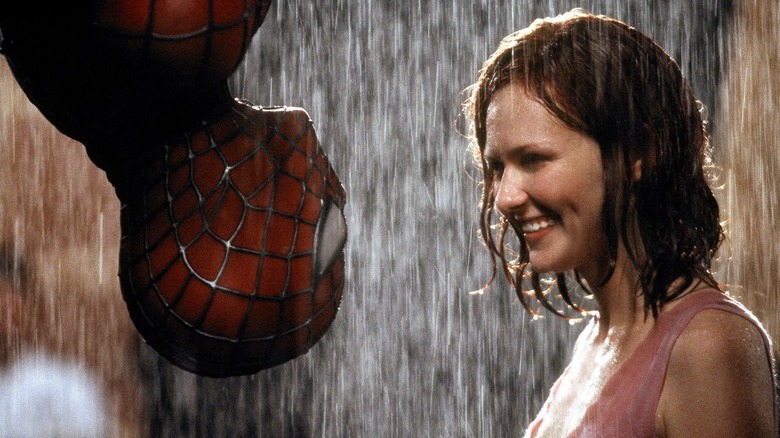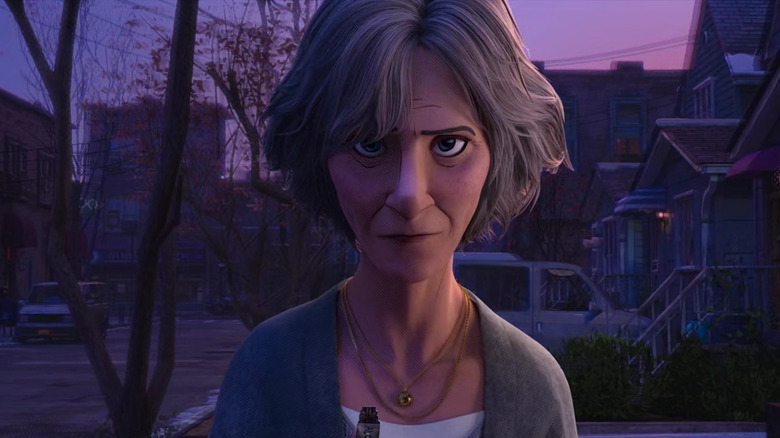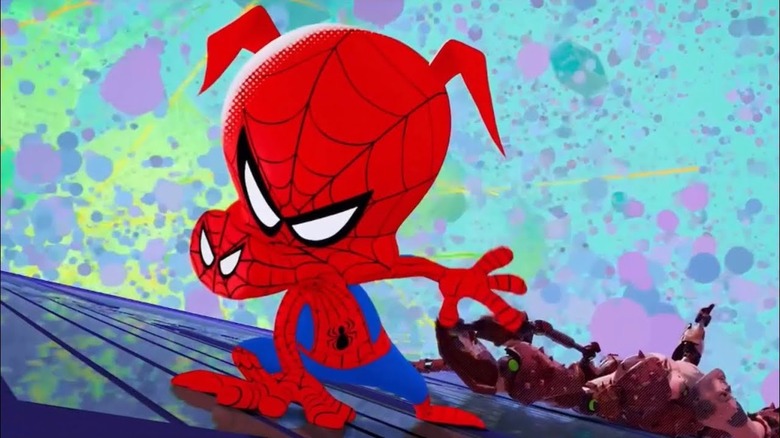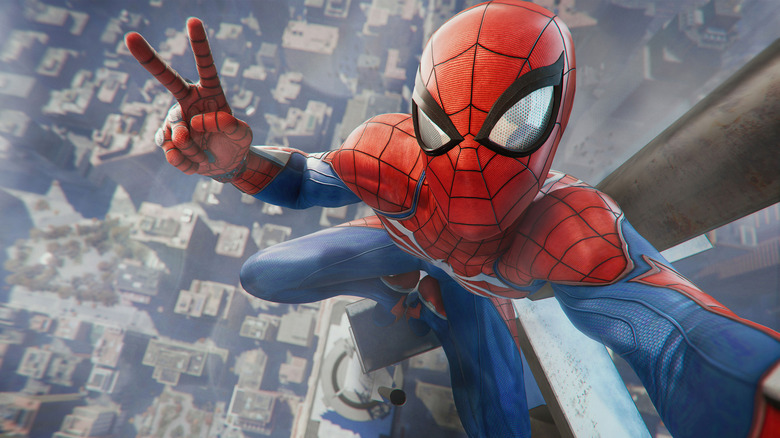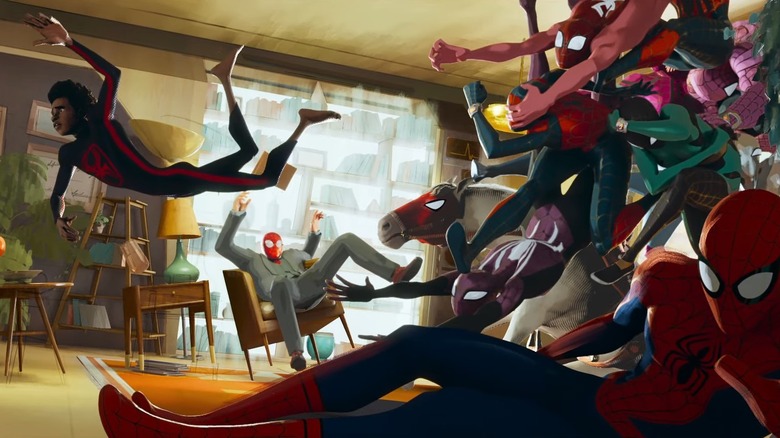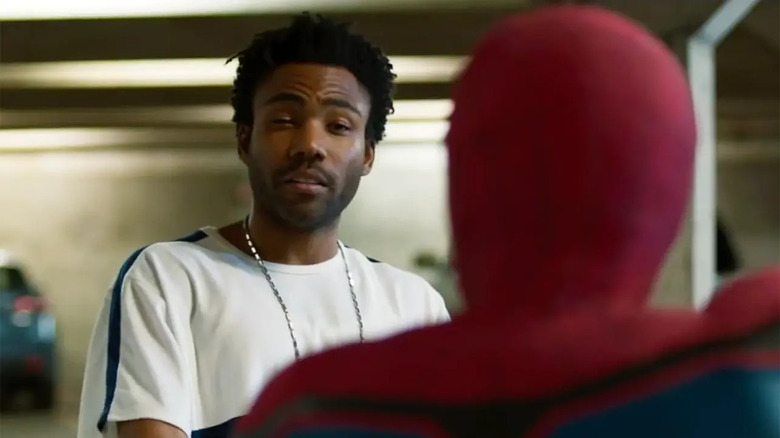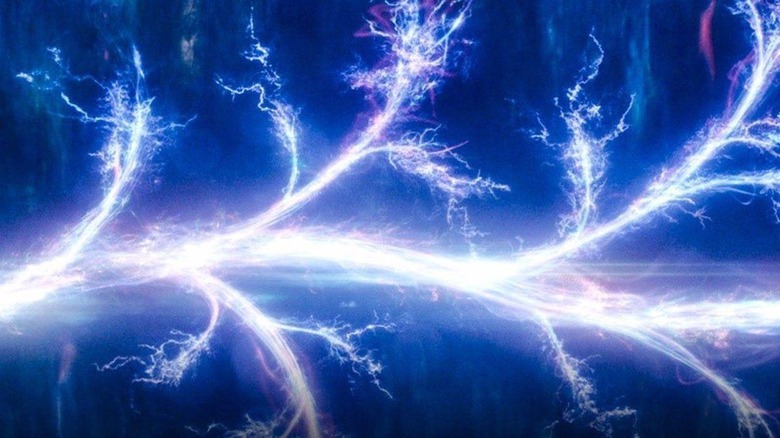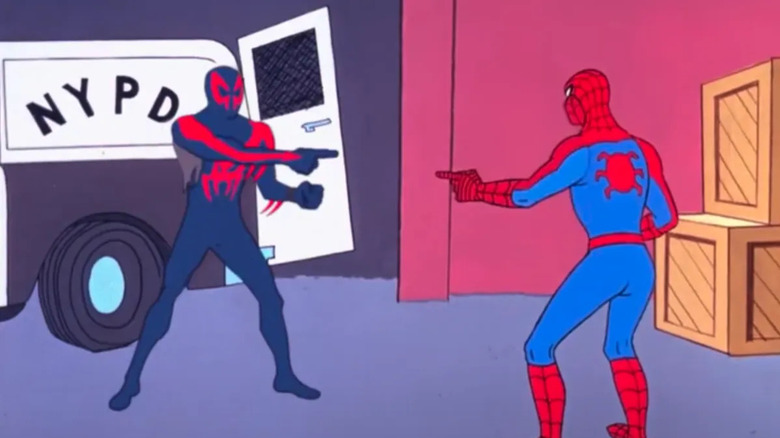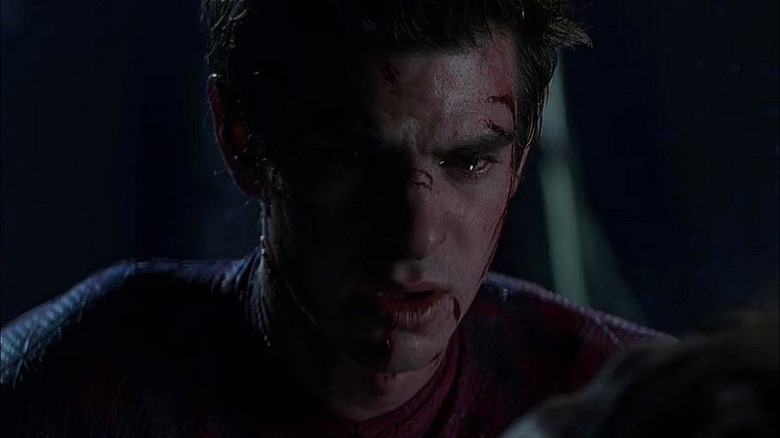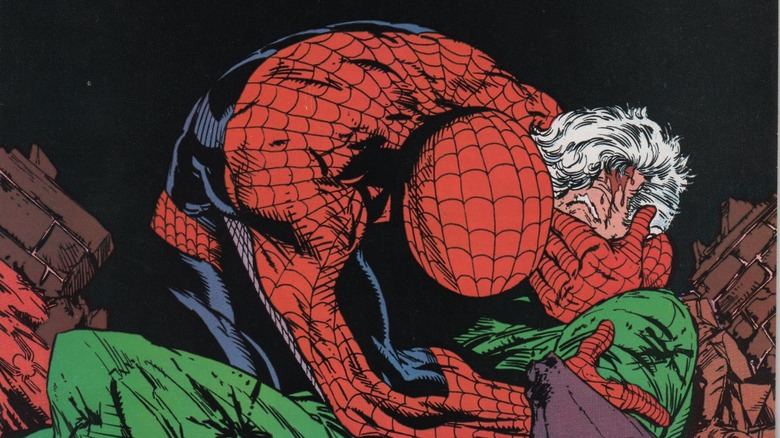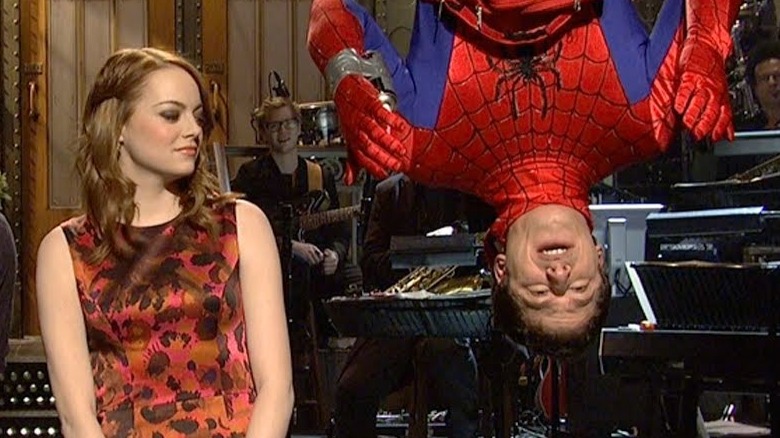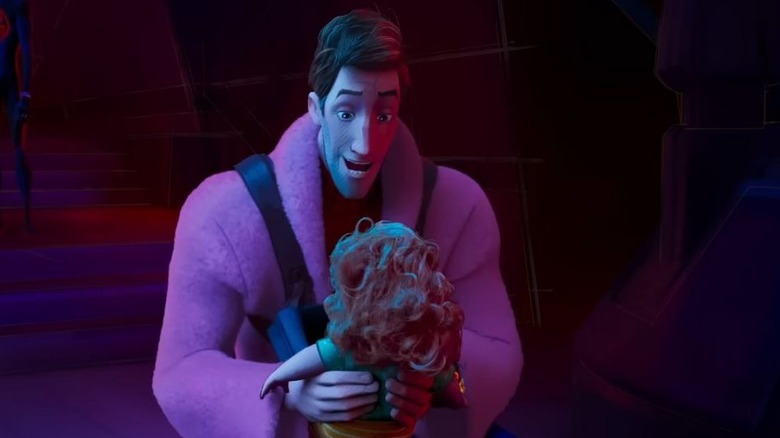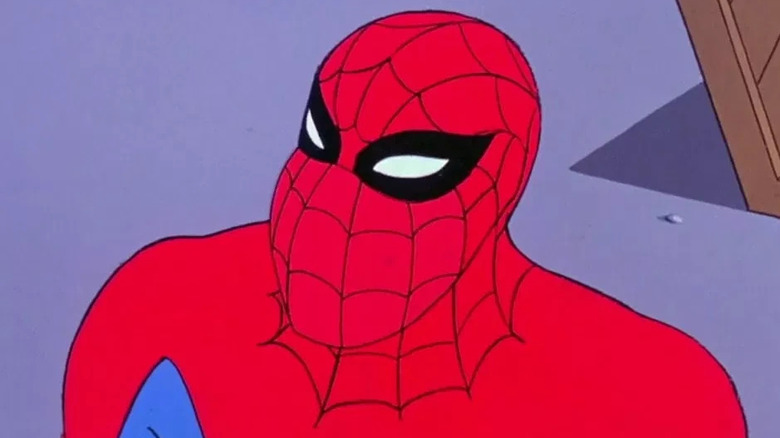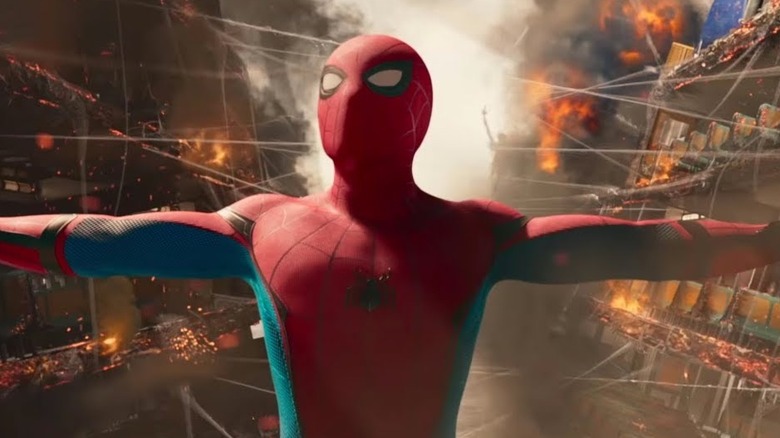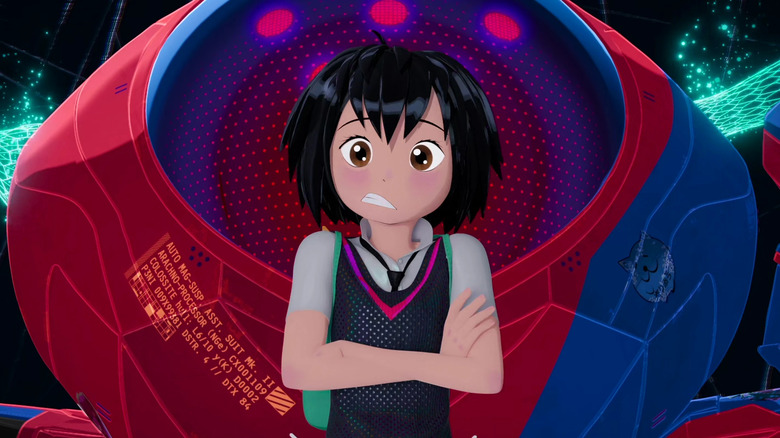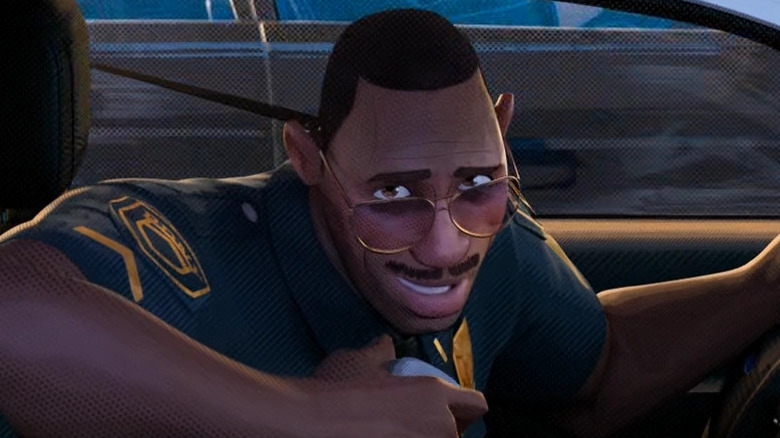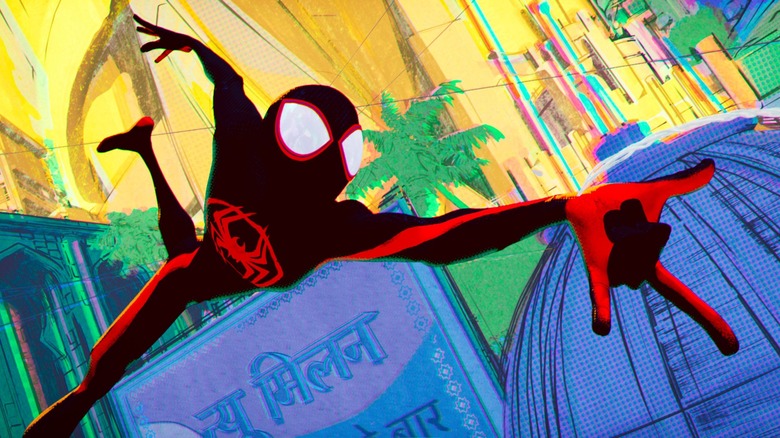Easter Eggs You Missed In Spider-Man: Across The Spider-Verse
Contains spoilers for "Spider-Man: Across the Spider-Verse"
"Spider-Man: Into the Spider-Verse" is one of the more beloved films in Marvel Comics' extensive cinematic history. Released in 2018, the film follows Miles Morales, a teenager who gets bitten by a radioactive spider (just like Peter Parker) and ends up having to save his universe from the evil doings of Kingpin, whose machinery threatens the stability of the multiverse. Along the way, Morales teams up with Spider-People from other universes, including Gwen Stacy, Peter B. Parker, and Peter Porker.
The film was critically acclaimed for its narrative and unique art design, paying tribute to the history of comic books and the character of Spider-Man with a staggering amount of Easter eggs. After four years, Miles Morales and company make their triumphant return in "Spider-Man: Across the Spider-Verse," which not only expands on the number of Spider-People, but dramatically raises the stakes for Miles as he is targeted by an unstable supervillain out for revenge.
While "Into the Spider-Verse" was a treasure trove of Easter eggs, "Spider-Man" fans will need quite the guide to steer them through all the Easter eggs that audiences may miss while watching "Across the Spider-Verse" for the first time. Whether it's subtle nods to the character's comic book origins, references to previous films in Sony's "Spider-Man" canon, or simply just callbacks to the previous film, these Easter eggs will both entertain fans of the franchise and keep you seated for the next "Spider-Verse" chapter coming in 2024.
Characters continue to be introduced with comic book montages
Though "Into the Spider-Verse" functions as a cohesive narrative, "Across the Spider-Verse" is the first part of a completed story, with "Beyond the Spider-Verse" set to pick up where it leaves off. However, "Across the Spider-Verse" isn't a reset from the first film, and continues to use a lot of the film language the original established. One of those motifs is the use of comic book covers to establish new characters, as well as catch up with older ones.
The film opens with narration from Gwen Stacy of Earth-65, examining her backstory as Spider-Woman and teasing her betrayal of Miles later on. Many of those who watched "Into the Spider-Verse" will recognize the similarities between this opening sequence and the introduction of Chris Pine's Peter Parker in the first film. Some fans may notice that Stacy's comic book cover drops on top of the existing covers that were shown in "Into the Spider-Verse," cementing this film as a continuation of the first. The trend also continues for the re-introduction of Miles, as well as the introduction of new characters like Spider-Man 2099, Pavitr Prabhakar, and Spider-Punk.
Furthermore, some of these comic book covers allude to the characters' narrative history. For Miles' first proper meeting with Miguel O'Hara, otherwise known as Spider-Man 2099, the comic book cover that flashes on screen directly references the first issue of "Spider-Man 2099," which was released in 1992.
Gwen Stacy's band references another love interest
Miles Morales remains the protagonist of "Across the Spider-Verse," but the extended opening of the film centers the narrative on Hailee Steinfeld's Gwen Stacy following the events of "Into the Spider-Verse." In her colorful painted universe, Gwen's life as Spider-Woman poses quite the threat as she reels from the guilt of mistakenly killing her best friend, while also being hunted down by her father, a police captain who seeks revenge against the anonymous Spider-Woman.
When she's not slinging webs and avoiding captivity, Gwen also shreds on the drum kit, which serves as the opening image of the film. After she's finally interrupted mid-solo, comic book fans will notice her bass drum, which is labeled "The Mary Janes." Obviously, this fictional band name is a direct reference to Mary Jane Watson, who is Peter Parker's other notable love interest (and who appears as the wife of Peter B. Parker, voiced by Zoë Kravitz).
However, Gwen's involvement in The Mary Janes dates back to her comic book origins. The band made their debut in Spider-Gwen's introductory comic, "Edge of Spider-Verse," released in 2014. In that comic, her fellow band members are established as Betty Brant (another romantic interest of Parker's), a version of Mary Jane Watson who later becomes Carnage, and Gloria Grant. Sadly, it appears as of the start of "Across the Spider-Verse," Gwen has moved on from her rock star dreams with her bandmates.
A familiar voice returns as Spider-Man's loudest critic
Over the years, many actors have taken on characters in the "Spider-Man" franchise, whether they are live-action or voice roles. However, only one performer has redefined an iconic antagonist of Peter Parker ever since he debuted as the character in Sam Raimi's 2002 "Spider-Man." That actor is none other than J.K. Simmons, who has gone on to win an Oscar for his performance in "Whiplash," but will forever be remembered as the voice behind J. Jonah Jameson of The Daily Bugle.
After appearing in Raimi's original trilogy, fans of Spider-Man were thrilled to see Simmons reprise his role as the Alex Jones-coded Jameson in a post-credits scene of "Spider-Man: Far From Home." Simmons then played a key role as Peter Parker's loudest critic in the follow-up, "Spider-Man: No Way Home," and makes a comeback via voiceover in "Spider-Man: Across the Spider-Verse," protesting the actions of Spider-People throughout the multiverse.
Though his role in the film isn't as prominent as his live-action appearances, "Spider-Man" fans won't have to pay close attention to hear the raging news reports of Jameson's character. The character even appears in the flesh — or rather, brick — during one sequence that takes place in the world of LEGO Spider-Man, which is the only time in the film Peter Parker's work at The Daily Bugle is referenced.
Gwen's backstory comes straight from her comic book origins
Gwen Stacy's backstory is only briefly alluded to in "Into the Spider-Verse," as her character introduction explains how her best friend, Peter Parker, became The Lizard and was subsequently defeated by Gwen in battle. However, the opening of "Across the Spider-Verse" delves deeper into the characters and what led to this moment, which all originates in Gwen Stacy's introduction as Spider-Gwen in Marvel Comics.
After getting bitten by a radioactive spider, Gwen begins living a double life as Spider-Woman, using her powers of super-strength to intimidate Peter Parker's bullies on the side. However, fed up with being picked on, Parker downs The Lizard's serum, turning himself into a monster that attacks their school prom as an act of revenge against the kids who bullied him. Gwen unknowingly kills Peter in the subsequent fight, and runs away when her father, Captain Stacy, shows up at the scene of the crime to find Spider-Woman standing over a murdered Peter Parker.
Although this is established in "Into the Spider-Verse" as Gwen's reasoning for remaining distant from others, its explanation in "Across the Spider-Verse" follows the arc from her debut comic. Some of the sequences in this extended opening even mirror panels from the comic, such as one moment when Peter injects himself with Dr. Connors' serum. Peter's final words to Spider-Gwen during this scene are even directly taken from the comic, revealing he knew her secret identity.
A significant update in the MCU's established canon
The world of Marvel films has been quite focused on the concept of the multiverse lately, from the bureaucracy policing the flow of time in "Loki," to the introduction of the next Avengers-level threat in the multiversal conqueror Kang. However, the multiverse has always been intrinsically tied with the world of "Spider-Man," with "Into the Spider-Verse" being the first Marvel film to delve into the comic book origins of the multiverse.
The multiverse also played a major role in the latest MCU Spider-Man film, "Spider-Man: No Way Home," in which Tom Holland's Peter Parker becomes the target of super-villains from the Sonyverse after convincing Doctor Strange to toy with the memories of everyone on Earth. These events are directly referenced in "Across the Spider-Verse" by Oscar Isaac's Miguel O'Hara during an early scene in the film as he describes the instability of the multiverse related to the events of the first "Spider-Verse" film, as well as Strange's actions.
However, this line from O'Hara also directly contradicts established MCU lore, which may actually come as a delight to hardcore Marvel fans. In "Doctor Strange in the Multiverse of Madness," the MCU universe is designated as Earth-616, the original universe of Marvel Comics. However, "Across the Spider-Verse" re-establishes it as Earth-199999, finally proving MCU producer Kevin Feige's statement wrong.
Spot has always been Miles Morales' ultimate nemesis
Despite being one of the more silly villains in the "Spider-Man" film canon, The Spot poses quite a threat to Miles Morales in "Across the Spider-Verse." After discovering that he can seamlessly jump between multiverses, The Spot becomes a target of the Spider-Society led by Spider-Man 2099, who blames Miles Morales for the supervillain's creation. Fortunately for fans of the first film, The Spot's origin story perfectly aligns with a recognizable moment from the film.
Formerly a scientist working for Alchemax named Dr. Jonathan Ohnn, he was present during Miles Morales and Peter B. Parker's escape just before they meet up with Spider-Gwen for the first time. As The Spot recalls, he was hit with a bagel and was later caught in the explosion of Kingpin's Super Collider, which morphed him into the portal-creating entity he now is. Although Miles was oblivious to his role in The Spot's creation, the character can clearly be seen in "Into the Spider-Verse."
During the Alchemax escape scene from "Into the Spider-Verse," audiences watch Miles throw a bagel that smacks a poor scientist in the face for comedic effect, complete with the onomatopoeia "Bagel!" It's a clever nod that "Across the Spider-Verse" makes to the previous film, while also justifying the intense hatred that The Spot has for Peter, driving him to grow even more powerful and subsequently threaten the life of Miles' father, the newly-minted police captain Jefferson Davis.
Ganke is offered a privileged position as Miles' sidekick
Ganke Lee, in Marvel Comics, is Miles Morales' best friend as well as one of the few people who knows his secret identity. However, the character's appearance in "Into the Spider-Verse" was as a minor non-speaking role, bearing witness to Miles and the other Spider-People hiding in their shared dorm room. However, Ganke makes a slightly more prominent appearance in "Across the Spider-Verse" when Miles stops in his dorm after capturing The Spot and asks Ganke to call the cops.
During the brief moment between Miles and Ganke, Ganke expresses disinterest in being Miles' "guy in the chair," which results in him not doing anything when The Spot eventually escapes captivity. For fans of the Marvel Cinematic Universe "Spider-Man" films starring Tom Holland, the phrase "guy in the chair" will ring familiar, as it's said many times by Peter Parker's friend Ned Leeds after he discovers the superhero identity of his best friend.
This Easter egg also references connective tissue between Ganke Lee and the MCU's Ned Leeds. (The two bear a closer connection than Ned's cinematic incarnation does with his comic book counterpart, who eventually becomes the Hobgoblin.) Although Ganke in "Across the Spider-Verse" is less enthusiastic about being an ally to Spider-Man, it still draws a connection between these two nerdy allies of Spider-Man.
Lord and Miller pay tribute to their past work
Phil Lord and Christopher Miller have a long history of producing and creating animated films, including "Cloudy with a Chance of Meatballs" and "The Mitchells vs. the Machines." The two also co-produced "Spider-Man: Into the Spider-Verse," and returned to help pen the scripts for both "Across the Spider-Verse" and 2024's "Beyond the Spider-Verse." Given their greater creative input on the second and third films of the trilogy, Lord and Miller saw an opportunity to pay tribute to one of their biggest successes in animation.
That success is "The LEGO Movie," which the creative duo co-wrote and co-directed, was released in 2014 to glowing reviews for its stop-motion animation and storytelling. The two also co-wrote and produced the film's 2019 sequel, "The LEGO Movie 2: The Second Part," as well as producing "The LEGO Batman Movie," "The LEGO Ninjago Movie," and spin-off Cartoon Network series "Unikitty!"
In "Across the Spider-Verse," Lord and Miller reprise their LEGO roots for a moment in the film where The Spot, while jumping between multiverses, ends up creating havoc in the stop-motion animated world of LEGO Spider-Man. Slipping away from his job at The Daily Bugle, LEGO Spider-Man himself contacts Miguel O'Hara and the Spider-Society to alert them to the danger of The Spot, setting off many of the events of the film. Though it's a moment mostly played for laughs, it's a fun Easter egg for Lord and Miller's past work.
A fan-favorite Sonyverse character makes a cameo
Phil Lord and Christopher Miller's work isn't the only thing referenced during The Spot's multiverse-jumping in "Spider-Man: Across the Spider-Verse." During the same sequence as when The Spot crashes into the LEGO Spider-Man world, The Spot also mistakenly ends up in the live-action Sonyverse, where he has a brief interaction with Mrs. Chen, played by Peggy Lu, the owner of a convenience store that Tom Hardy's Eddie Brock frequents in "Venom" and its sequel, "Venom: Let There Be Carnage."
Hilariously, Mrs. Chen is unfazed by the presence of The Spot, which may have something to do with the fact that she is briefly a symbiote host in "Venom: Let There Be Carnage." However, the presence of "Venom" in the wider multiverse of "Across the Spider-Verse" was established way back when "Venom" was first released in 2018, as a post-credits sequence depicted a scene from the upcoming "Spider-Man: Into the Spider-Verse" with the title card, "Meanwhile, in another universe...," which Gizmodo claimed "may have changed everything when it comes to Spider-Man movies."
Given Tom Hardy's appearance in a post-credits scene of "Spider-Man: No Way Home," it can be implied that the "Venom" movies also take place in an alternate universe from the MCU's Earth-199999. Hopefully, this "Venom" Easter egg is just the first step to hinting at the possibility of live-action Spider-Men like Tom Holland, Tobey Maguire, and Andrew Garfield making cameo appearances in 2024's "Beyond the Spider-Verse."
Miles' connection to the number 42 grows larger
The existence of the multiverse plays an integral part in Miles Morales' origin story in "Spider-Man: Into the Spider-Verse," which becomes even more prevalent in "Across the Spider-Verse." While hanging out at night with his Uncle Aaron, Miles is — like many Spider-People across the multiverse — bitten by a radioactive spider. However, what makes Miles an anomaly is that his spider came to his homeworld of Earth-1610 from a different universe, Earth-42, with Miles' acquisition of powers resulting in the death of his universe's Peter Parker and the instability of the multiverse.
Though this fact plays an important role in why Miguel O'Hara targets Miles, as well as why Miles himself ends up on Earth-42 at the end of the film, the spider that bit Miles being from that numbered universe is no coincidence. According to the director of "Into the Spider-Verse," it was an intentional choice to have both the spider that bit Miles be from Earth-42, as well as to have Miles wear the baseball jersey of the legendary Jackie Robinson, who also wore the number 42.
The number 42 also holds additional meaning for sci-fi fans. In "The Hitchhiker's Guide to the Galaxy," 42 is established as the answer to, as the book states, "the ultimate question of life, the universe, and everything." If Miles is indeed the greatest anomaly to the Spider-Verse as O'Hara claims he is, then it makes sense that the many 42 Easter eggs mean so much.
An iconic Spider-Man moment is nearly recreated
In the history of "Spider-Man" as a film franchise, there is probably no scene as iconic as this romantic moment in Sam Raimi's 2002 film. After rescuing Mary Jane Watson (played by Kirsten Dunst) from a group of muggers in the rain, an upside-down Tobey Maguire passionately kisses his high school crush. Not only is the scene one of cinema's greatest on-screen smooches, but it's also a defining moment for Mary Jane Watson in both the films and comics, who is only attracted to Peter Parker after learning his identity as Spider-Man.
While few romantic pairings have been able to hold a candle to Maguire and Dunst in "Spider-Man," Miles and Gwen's flirtations in "Spider-Man: Across the Spider-Verse" come pretty close. After a day spent talking about their Spider-problems and chasing each other throughout New York, the two part ways as Gwen secretly has other business to attend to. Miles, turning himself invisible, follows her to a destroyed lab where she's investigating The Spot, discovering that the supervillain has given himself enough power to continue verse-jumping.
Before Gwen disappears into a portal to chase down The Spot, she turns around, unknowingly face-to-face with an upside-down, invisible Miles. Though they don't end up locking lips, the tension is quite palpable as Miles watches Gwen bid him farewell before leaving. It's a nice homage to one of the most iconic scenes in "Spider-Man" history, and sets up their romantic tension to continue in the next film.
Aunt May's move has comic book origins
Aunt May is an incredibly integral character in the "Spider-Man" franchise, as the greatest responsibility of Peter Parker and a reminder of all that he's lost. However, Aunt May is not immune to tragedy herself, as seen in "Spider-Man: Into the Spider-Verse," where she's forced to move on after the sudden death of the Peter Parker of Miles' universe. Nevertheless, she comes to the rescue when she reveals to Miles, Peter B. Parker, and Gwen Stacy that she's been harboring fugitive Spider-People, including Spider-Man Noir and Spider-Ham.
Sadly, Aunt May isn't as present in "Spider-Man: Across the Spider-Verse," with Miles establishing early in the film that she moved to Florida. Though this seems like a random fact, it actually has some basis in Aunt May's comic book origins. Particularly, it ties the Aunt May of the "Spider-Verse" movies with the Aunt May in Miles' homeworld of Earth-1610 in the comics. That universe's Aunt May has family that lives in Florida, making her move there in "Across the Spider-Verse" potentially a homecoming for her.
Of course, Florida is also a popular state for elderly citizens to retire in, making Aunt May's choice of new destination nondescript. Still, with Lord and Miller's "Spider-Verse" films, no details go unnoticed, so it's highly likely that Aunt May has her own adventure ahead of her when she arrives in the sunshine state.
Editor's notes provide comic book context
"Spider-Man: Into the Spider-Verse" was heralded as an outstanding tribute to the history of Marvel Comics, with Cinemablography deeming it "a love letter to comic book storytelling, superheroes, and Spider-Man." Not only do the different characters of the films embody differing comic book aesthetics, but the film's narrative also cleverly utilizes comic book tropes to enhance the storytelling. One example of this is through its use of comic book flourishes to make "Into the Spider-Verse" as well as "Across the Spider-Verse" feel like a comic book page brought to life.
In "Across the Spider-Verse," there are many moments that utilize "Editor's Notes" which briefly flash on-screen to, as they do in comics, provide context for the audience on characters, cultural differences, and unexplained lore. However, one Editor's Note in "Across the Spider-Verse" makes a callback to a beloved character from "Into the Spider-Verse": Spider-Ham, voiced by comedian John Mulaney.
During the confrontation between the Renaissance Vulture and Gwen Stacy, Miguel O'Hara, and Jessica Drew, O'Hara comments on Vulture's use of "Hammerspace." According to an Editor's Note, "Hammerspace" refers to a cartoon character's ability to pull objects, such as a large hammer, out of their pockets seemingly from thin air. Obviously, those who have seen "Into the Spider-Verse" recognize this as an ability possessed by Spider-Ham, who actually does pull a comically-large hammer out of his pocket during one of the film's climactic fight scenes.
Insomniac's Spider-Man makes an appearance several times
The same year as the release of "Spider-Man: Into the Spider-Verse," the "Spider-Man" franchise expanded into the world of video games as well. Insomniac Games released "Spider-Man" for the PlayStation 4 in 2018, which was later ported to PS5 and PC. Since then, Insomniac has developed several expansions and sequels, including 2020's "Spider-Man: Miles Morales" which re-tells the origin story of the "Spider-Verse" protagonist and his partnership with Peter Parker.
Suffice it to say, the Insomniac Games iterations of "Spider-Man" make multiple appearances in "Spider-Man: Across the Spider-Verse." At first, Miles' roommate Ganke Lee can be seen playing "Spider-Man" on his TV instead of writing an essay during several early scenes in the film. However, the more prominent cameo comes way later in the film, when Miles is being taken to meet Spider-Man 2099 in the Spider-Society's headquarters.
At one point, the Insomniac Spider-Man, as well as Insomniac's Miles Morales, appear among the residents of Nueva York, in a full CGI render just like in the games. Their appearance in the film is mainly due to the Insomniac Games being given official comic book continuity as established by the comic book tie-in "Spider-Geddon," which was released in 2018 alongside the first game. Hopefully, the character can make an even bigger appearance in "Spider-Man: Beyond the Spider-Verse," featuring the return of voice actor Yuri Lowenthal.
The many different Spider-People of Nueva York
The climax of "Spider-Man: Across the Spider-Verse" comes when Miles Morales is taken to Nueva York on Earth-928, where Miguel O'Hara has gathered the Spider-Society whose main goal is to protect the multiverse from threats or anomalies. The sequence where Miles Morales is introduced to this society is filled with more cameos than one audience member would be able to spot in one sitting. Predictably, most of these alternate Spider-People originate from comic books or other official Marvel-produced "Spider-Man" content.
Among some of the highlights includes Otto Octavius's Superior Spider-Man, while Alfred Molina cameos as Doc Ock through archival use of his voice from "Spider-Man: No Way Home." Other Spider-People that appear include Spider-Doppelganger, Iron Spider, Julia Carpenter's Spider-Woman, Web-Slinger, Peter Parkedcar, Spider-Man 2211, Ultimate Tarantula, and Flash Thompson's Captain Spider, all of whom originally appeared in various iterations of Marvel Comics.
Once Miles discovers that he is one of the anomalies and refuses to let his father be killed by Spot in order to maintain a canon event, he is chased by the entire Spider-Society, resulting in the appearance of even more Spider-People. One of the film's standout moments of comedy occurs when a therapy session between a Spider-Man and his Spider-Therapist is interrupted by Miles running through, chased by a crowd of Spider-People.
Miles Morales' inspiration fulfills a long-anticipated teaser
One of the most surprising cameos in "Spider-Man: Across the Spider-Verse" has been a long time in the making. At one point during Miles' exploration of the Spider-Society's headquarters, he meets an alternate version of his uncle Aaron Davis, aka The Prowler. But this version of Aaron Davis is played by a live-action Donald Glover, who originally debuted the character in the MCU's "Spider-Man: Homecoming" as a low-level criminal whom Tom Holland's Peter Parker interrogates for information about the Vulture.
Although a deleted post-credits scene in "Homecoming" teased Glover's Aaron Davis' close relationship with Miles Morales, the character has yet to re-appear in the film franchise. While the appearance of Glover is enough to satisfy many fans, it also serves as an Easter egg to the origin of Miles Morales as a character. According to comic book creator Brian Michael Bendis, Miles' design was inspired by Glover, who was the subject of an online fan campaign to get him cast as Peter Parker in "The Amazing Spider-Man," and later wore a Spider-Man t-shirt on "Community" in reference to it.
That "Community" scene also briefly appears in "Spider-Man: Into the Spider-Verse" on Aaron Davis' TV, but having Glover appear in the flesh in Nueva York serves as an even better tribute to Miles' inspiration. Glover is also set to star in a future Sonyverse film as the minor comic book character Hypno Hustler, a frequent antagonist of Spider-Man.
The MCU's multiverse aesthetic is carried over
The multiverse has played a major role in the on-screen Marvel universe lately, all thanks to "Spider-Man: Into the Spider-Verse." In the years following the end of the Infinity Saga in the Marvel Cinematic Universe, Marvel characters have begun exploring the multiverse, beginning with the 2021 Disney+ series "Loki," which centers on the god of mischief being recruited by the mysterious Time Variance Authority, whose goal is to maintain the sanctity of the Sacred Timeline, which predictably ends with disaster.
In the first season finale of "Loki," Loki and his female variant Sylvie bear witness to the Sacred Timeline beginning to split as a result of their confrontation with He Who Remains (aka Kang the Conqueror). Fans' minds were etched with the image of the blue tree-like timestream branching off into different paths, with the imagery recurring when Peter Parker damaged the multiverse in "Spider-Man: No Way Home" before reversing the effects by making everyone forget about him.
When Miguel O'Hara explains to Miles Morales how the multiverse works in "Spider-Man: Across the Spider-Verse," this familiar imagery makes a return, as O'Hara showcases a hologram of the branching blue stream with the help of his A.I. assistant Lyla. With the multiverse set to play a big role in the rest of the MCU, the connectivity between these films help to cement the media franchise's consistent logic throughout.
The most iconic Spider-Man meme makes its third cinematic appearance
At this point, Sony Pictures have gotten a little obsessed with making reference to one popular "Spider-Man" meme in their films. In the post-credits scene of "Spider-Man: Into the Spider-Verse," Miguel O'Hara is introduced as Spider-Man 2099 as he travels to the universe of the 1967 "Spider-Man" animated series, recreating the meme image of two Spider-Men pointing at each other in an alley.
The meme was again referenced in "Spider-Man: No Way Home" when Tom Holland, Andrew Garfield, and Tobey Maguire all united on-screen as three variants of Peter Parker. While the scene in the film finds the three confused as to which Peter Parker Ned Leeds is trying to talk to, the three actors also recreated the image during a behind-the-scenes costume fitting. Now, with the release of "Spider-Man: Across the Spider-Verse," the meme makes its on-screen appearance for a third time, albeit under slightly different circumstances.
After learning of the Spider-Society's intention to let Miles' father be killed by The Spot, Miles makes an escape from their facility as O'Hara orders everyone to find "Spider-Man." In one of the funniest moments in the film, the hundreds of Spider-People in Nueva York begin pointing at each other accusingly before O'Hara corrects himself and tells them to find Miles Morales specifically. Although audiences are far from getting sick of the joke, it's yet to be seen if Sony will reprise the meme once again for "Spider-Man: Beyond the Spider-Verse."
Familiar Spider-Men show up thanks to archival footage
Leading up to the climax of the "Spider-Verse" trilogy, longtime "Spider-Man" fans are understandably anxious to see if their favorite live-action Spider-Men make an appearance. The door is officially open for their return after Andrew Garfield and Tobey Maguire appeared in "Spider-Man: No Way Home," even as Garfield constantly denied rumors he was involved in the project. Although Holland, Garfield, and Maguire don't make new appearances in "Spider-Man: Across the Spider-Verse," fans of their characters will be pleased by what they do see.
In Miguel O'Hara's extensive monologue about the fate of Spider-People to experience loss, archival footage from 2012's "The Amazing Spider-Man" and 2002's "Spider-Man" is shown. In Garfield's brief appearance, he's seen mourning the fallen Captain George Stacy, father of Gwen Stacy, while Maguire is seen crying over the dying Uncle Ben.
While these cameo appearances are pretty obvious-to-spot Easter eggs, their relevance to Miles' story in "Across the Spider-Verse" is nevertheless powerful. There's no better way to prove to an audience just how much loss Spider-Man is destined to experience than by showing the loss audiences themselves have experienced alongside him, similar to Tom Holland's Peter Parker losing Aunt May and Tony Stark in the Marvel Cinematic Universe. These scenes could also possibly tease Miles teaming up with Tom Holland, Andrew Garfield, and Tobey Maguire in "Beyond the Spider-Verse," which just might top the surrealism of seeing them work together in "No Way Home."
Canon events tie the Spider-Society to comic book lore
"Spider-Man: Across the Spider-Verse" has also established the multiversal lore of Canon Events, which Miguel O'Hara describes as recurring moments throughout the lives of all Spider-People. Some Canon Events include being bitten by a radioactive spider, losing a mentor and friend, and the guilt of letting an important police captain in their life die. Miles directly prevents one from happening when he rescues Captain Singh from near-death in Pavitr Prabhakar's Earth-50101.
During O'Hara's explanation sequence, many Spider-People mourning police captains can be seen, with some moments even taken directly from the pages of Marvel Comics as an Easter egg for hardcore "Spider-Man" fanatics. The reveal of this to Miles means danger, given that his father Jefferson Davis has recently been promoted to captain. However, he happens to be the only Spider-Person who is unwilling to accept this, with even Gwen Stacy and Peter B. Parker trying to stop him from returning to his universe to save his father.
Although these Canon Events are being used to establish Miles' inability to change the future, they serve as subtle nods to the fact that although there are countless Spider-People in "Across the Spider-Verse," they're all bound by similar story purposes and narrative arcs that have made them into the heroes they are. Can Miles be even greater than them without experiencing that kind of tragic loss?
The Lonely Island lend their voices to the Spider-Verse
Even the casting choices of "Spider-Man: Across the Spider-Verse" contain Easter eggs. Among the varied voice cast, which includes film and TV stars like Hailee Steinfeld, Jake Johnson, Oscar Isaac, and Issa Rae, there are also two members of The Lonely Island, a sketch troupe that gained notoriety on "Saturday Night Live" for creating viral Digital Shorts like "Lazy Sunday" and "The Shooting." Jorma Taccone, who previously voiced several minor characters in "Into the Spider-Verse," appears early on as a variant of the Vulture inspired by Leonardo da Vinci.
Alongside Taccone, Andy Samberg also makes an appearance in the film as Ben Reilly, a.k.a. Scarlet-Spider, a moody variant who serves as a high-up member of Miguel O'Hara's Spider-Society. Reilly, a clone of Peter Parker, made his comic book debut in 1975, before he later adopted the Scarlet-Spider persona in the '90s. During his first appearance in the film, Samberg's Reilly is seen in Nueva York mourning his tragic backstory with pageantry, before later joining O'Hara in hunting down Morales in Earth-1610.
Samberg's appearance in particular may be an Easter egg to his work on "Saturday Night Live," as the comedian appeared on several occasions dressed as Spider-Man hanging upside down. One of those times was during the monologue of Emma Stone in 2011, where he unsuccessfully tried to recreate the 2002 film's iconic make-out scene with her in front of her then-boyfriend and co-star Andrew Garfield.
Peter Parker's superpowered daughter makes her screen debut
Despite his importance to Miles Morales' story in "Spider-Man: Into the Spider-Verse," Jake Johnson's Peter B. Parker doesn't appear in "Across the Spider-Verse" until towards the end, when he's revealed to be another member of Miguel O'Hara's Spider-Society (albeit, not one of O'Hara's favorites). With him, Parker has taken along his infant daughter, Mayday Parker, who has adopted her father's ability to climb walls, which she constantly uses to evade his watch.
Mayday Parker is a fairly important character in Marvel Comics history, first appearing in a "What If...?" comic from 1997 where Mary Jane Watson never loses her baby with Peter Parker. Mayday Parker is instead born and becomes Spider-Girl, though in that comic Mayday's powers don't develop until she's a teenager. She later made her official Marvel Comics debut after positive fan response to the "What If...?" comic.
Though the infant Mayday gets most of the attention in "Across the Spider-Verse," other variants of Mayday also appear throughout the Spider-Society sequence, albeit ones that come from a different universe than Peter B. Parker's. Hopefully, when she returns in "Spider-Man: Beyond the Spider-Verse," Mayday gets to be a bigger part of the action alongside her father. Although some fans aren't optimistic about Peter B. Parker's chances of survival in the upcoming film in the trilogy, Mayday may get to take up the mantle from her father at some point in the franchise.
'60s Spider-Man makes a triumphant return
After a cameo appearance in the post-credits scene of "Spider-Man: Into the Spider-Verse," the Spider-Man from the 1967 ABC animated series makes a return appearance in "Across the Spider-Verse." This variant of Spider-Man is ostensibly implied to be the first one recruited by Miguel O'Hara for the Spider-Society after the events of the first film's post-credits scene, once they overcame their confusion at looking alike.
This classic version of Peter Parker pops up during Miles Morales' escape from Nueva York, appearing as the sole Spider-Person standing in Miles' way as he swings his way out. Unfortunately, this version of Spider-Man doesn't pose much of a threat and is almost immediately dispatched by Miles, which perhaps serves as a callback to the character's incompetence during the previous film's credits scene.
This Peter Parker isn't even the only Spider-Man who debuted on TV to make an appearance in "Across the Spider-Verse." The Japanese Spider-Man from the 1978 Japanese live-action series also shows up as part of the Spider-Society, accompanied by Josh Keaton's version of Peter Parker from "The Spectacular Spider-Man," which aired on The CW and Disney XD from 2008 to 2009.
The most beloved web-slinging moves are present
There are some particular moves that recur throughout the "Spider-Man" franchise, especially on screen. Some of these moves are what make certain "Spider-Man" scenes so iconic, as well as showcasing the strength and resilience of Peter Parker in the face of danger. As a love letter to the history of "Spider-Man" on and off-screen, "Spider-Man: Across the Spider-Verse" contains many moments that hark back to some of the classics.
During one sequence where Miles, Gwen, and Pavitr attempt to stop The Spot from wreaking havoc in Mumbattan, an alternate version of Manhattan in Earth-50101, Spider-Man India rescues a bus full of citizens, including his girlfriend, from falling off a bridge. Some fans noticed the resemblance between this moment and 2002's "Spider-Man," where Spider-Man rescues a group of citizens, including Mary Jane Watson, from the Roosevelt Island Tramway, as well as "Spider-Man: Homecoming," where Peter saves his classmates from the Washington Monument.
Another iconic Spider-Man move that's referenced in "Across the Spider-Verse" is Tom Holland's pulling together of two halves of a ferry in "Spider-Man: Homecoming," which is referenced by a lone Spider-Man in Nueva York making himself into a bridge that a crowd of Spider-People try to run across, resulting in everyone falling into an abyss. Though it's a more humorous moment, it nevertheless shows how all types of Spider-Men try to sacrifice themselves to save others — even if they end up failing.
Peni Parker returns with a tribute to her comic origins
The ending of "Spider-Man: Across the Spider-Verse" features some familiar faces for audience members who loved "Spider-Man: Into the Spider-Verse." Abandoned by the Spider-Society, Gwen Stacy realizes that Miles has ended up in the wrong universe, and recruits a team of Spider-People to help rescue him from the clutches of his alternate self. That group includes "Into the Spider-Verse" characters like Peni Parker, Peter Porker, and Spider-Man Noir, as well as Peter B. Parker and Mayday.
However, Peni Parker's SP//dr mech has received some upgrades since the last time audiences saw her in "Into the Spider-Verse." In that film, her mech resembled an actual spider, but this time around, it bears a closer resemblance to Peni Parker's original SP//dr design from her "Edge of Spider-Verse" comic debut, which was created by "Umbrella Academy" creator/My Chemical Romance vocalist Gerard Way and Jake Wyatt.
In turn, the comic book version of the SP//dr mech is its own Easter egg. The storyline of Peni Parker drew lots of inspiration from "Neon Genesis Evangelion," a Japanese anime centered on a teenage boy who pilots a weaponized mech, just like Peni. According to Wyatt, he included several characters from "Neon Genesis Evangelion" as Peni's classmates in the "Edge of Spider-Verse" comic as a tribute to their inspiration, which is now set to carry through into "Spider-Man: Beyond the Spider-Verse."
Miles' creators are paid tribute to alongside another character
The twist ending of "Spider-Man: Across the Spider-Verse" finds Miles mistakenly ending up in the wrong universe after using Miguel O'Hara's technology to send himself home. Since the spider that bit him was from Earth-42 rather than Earth-1610, Miles ends up in the former rather than the latter, finding himself in a version of his world where there is no Spider-Man, and even worse, Miles has been raised by his uncle Aaron to become the Prowler.
What truly changes things for Miles is when Aaron takes him to the roof of Miles' building, and Miles sees a graffiti tribute to his father, Jefferson Davis, where one was in his universe for Aaron. However, many fans who are shocked by this turn of events will probably be too distracted to notice a subtle nod to the creators of Miles Morales in this tribute. Spray-painted in faint green ink near Jefferson Davis' graffiti memorial are the words "Bendis" and "Pichelli," which refer to writer Brian Michael Bendis and illustrator Sara Pichelli.
The two creators of Miles Morales are probably used to being referenced in this way, as they also appeared in Miles' phone contacts in "Spider-Man: Into the Spider-Verse." Bendis and Pichelli are also referenced in "Spider-Man: Homecoming" in the files for Donald Glover's Aaron Davis, with one of his criminal aliases being "Brian Pichelli." However, it probably means a lot to be memorialized next to Earth-42's fallen police captain.
To be continued...
Overall, "Spider-Man: Across the Spider-Verse" pays tribute to Marvel Comics in ways that go even further than its predecessor did in 2018. From the unbelievably gorgeous aesthetics of each universe to the carefully-plotted narrative that challenges Miles physically and philosophically, "Across the Spider-Verse" is arguably among the best comic book movies ever made.
The loyalty "Across the Spider-Verse" has to comic book storytelling will get audiences excited for the next installment coming in 2024, "Spider-Man: Beyond the Spider-Verse." Just as "Across the Spider-Verse" seems to be ramping up to its point of highest tension, the screen goes black, and a panel written in comic book font reading "To be continued..." flashes on the screen. It's one of the biggest comic book movie cliffhangers since Thanos won at the end of "Avengers: Infinity War."
However, nothing is more true to comic book storytelling than leaving readers anxious to pick up the next copy to find out what happens next. That being said, this pulling of the rug may frustrate some audience members who find themselves just too invested to go home without a proper ending to this film. They'll be sitting in anticipation for nearly a year until they find out how this jaw-dropping installment of the "Spider-Man" franchise concludes.
